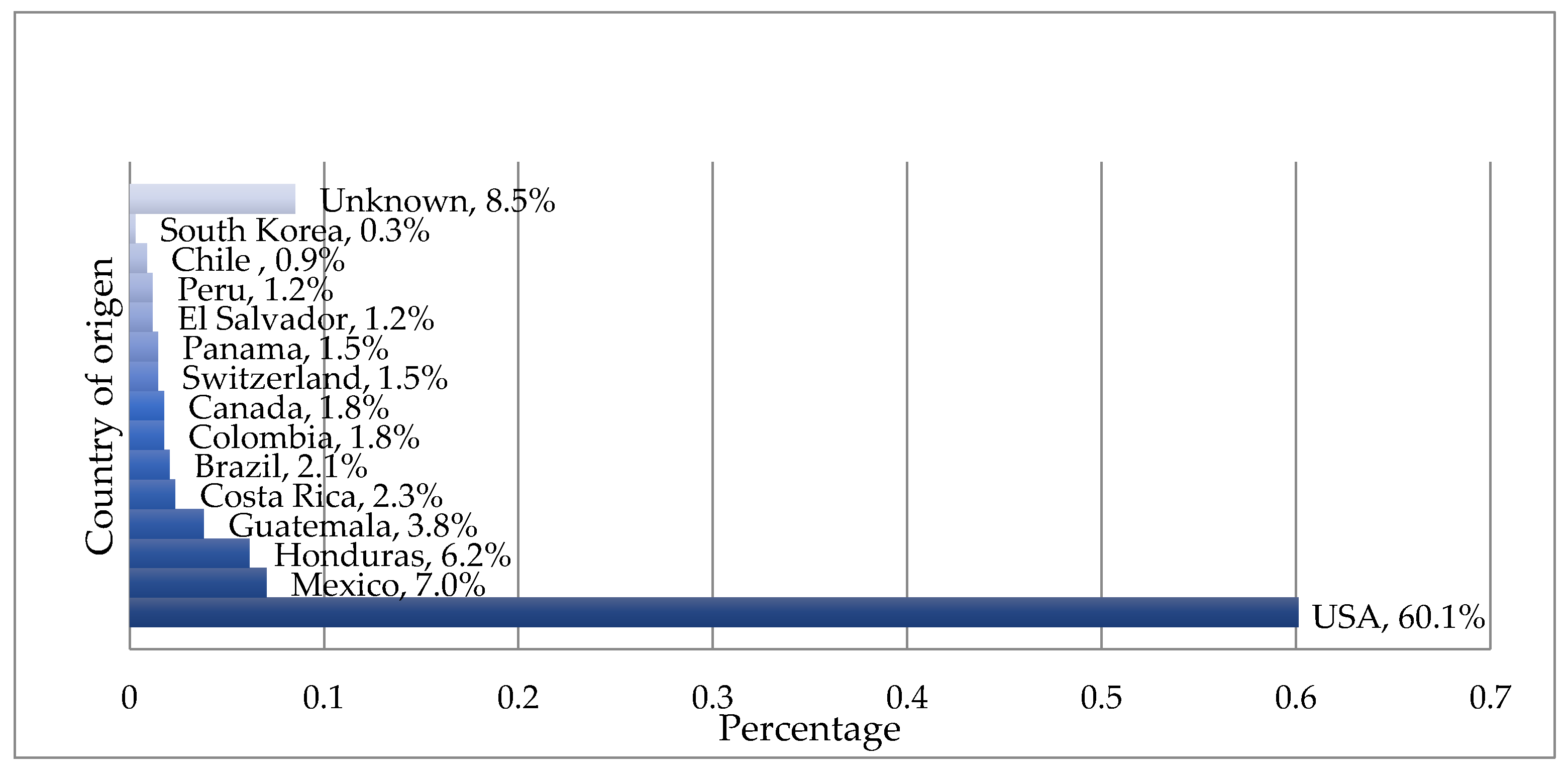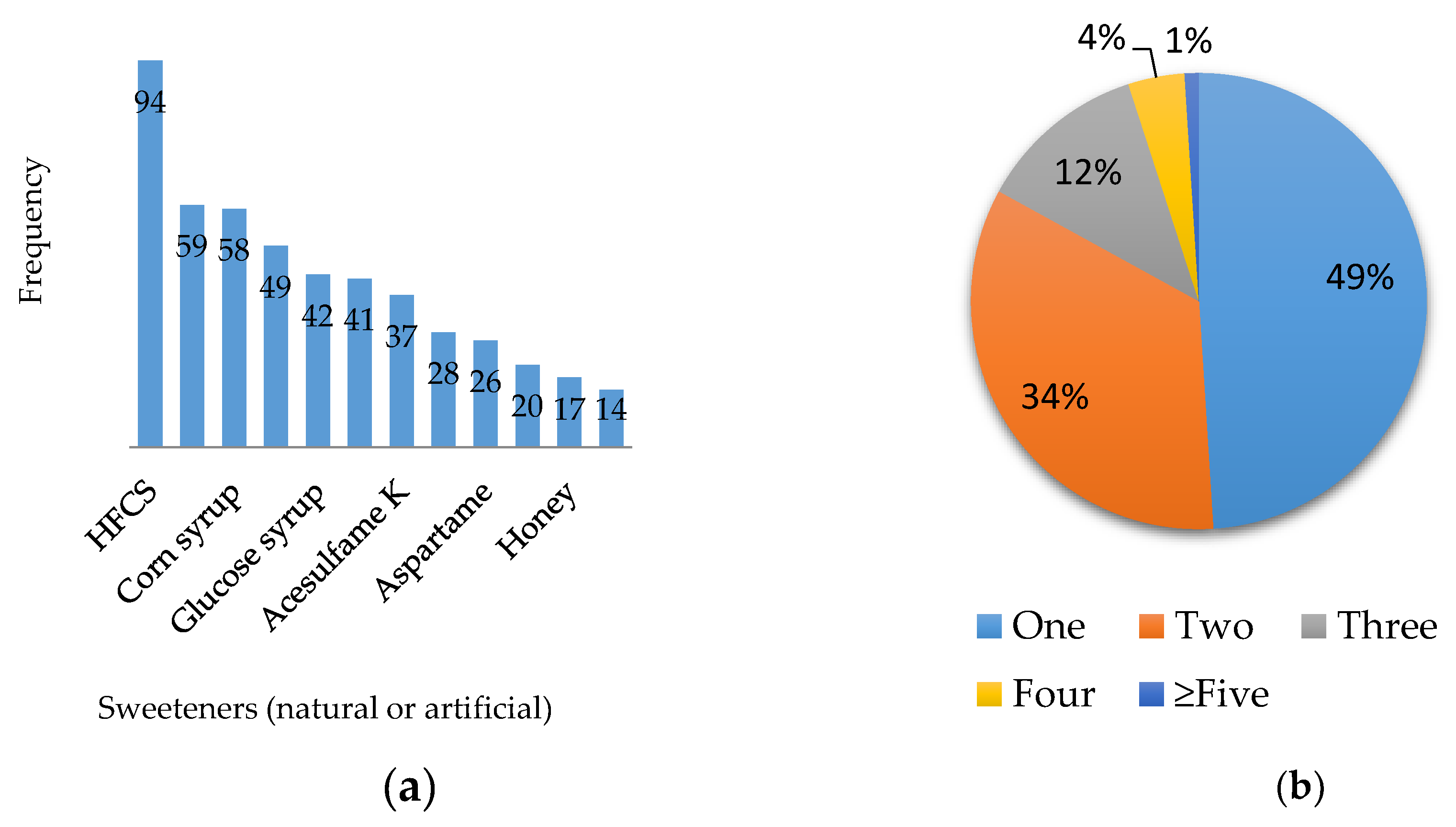Characterization of the Types of Sweeteners Consumed in Honduras
Abstract
1. Introduction
2. Materials and Methods
3. Results
3.1. Sweeteners by Food Category
3.2. Origen of Processed Foods with Sweeteners
3.3. Number of Times That Sweeteners were Mentioned in Processed Foods and Frequency in the Content of the Same Product
4. Discussion
5. Conclusions
Acknowledgments
Author Contributions
Conflicts of Interest
References
- Programa de las Naciones Unidas para el Desarrollo. Informe sobre Desarrollo Humano 2016. Nueva York, Estados Unidos: Naciones Unidas. 2016. Available online: http://www.undp.org/content/dam/undp/library/corporate/HDR/HDR2016/HDR_2016_report_spanish_web.pdf?download (accessed on 24 November 2017). (In Spanish).
- Honduras Economic DNA: Maintaining Commitment—With a Special Focus on Poverty and Shared Prosperity. Available online: http://documents.worldbank.org/curated/en/150731468189533027/Honduras-economic-DNA-maintaining-commitment-with-a-special-focus-on-poverty-and-shared-prosperity. (accessed on 3 February 2018).
- Economy and Business Opportunities from Honduras. Available online: http://www.globaltenders.com/economy-of-honduras.php (accessed on 7 February 2017).
- Food and Agricultural Import Regulations and Standards—Narrative. Available online: https://gain.fas.usda.gov/Recent%20GAIN%20Publications/Food%20and%20Agricultural%20Import%20Regulations%20and%20Standards%20-%20Narrative_Tegucigalpa_Honduras_12-8-2016.pdf (accessed on 7 February 2017).
- High-Intensity Sweeteners. Available online: https://www.fda.gov/food/ingredientspackaginglabeling/foodadditivesingredients/ucm397716.htm (accessed on 24 November 2017).
- Menchú, M.T.; Méndez, H. Análisis de la Situación Alimentaria en Honduras; INCAP: Ciudad de Guatemala, Guatemala, 2012. (In Spanish) [Google Scholar]
- RIESGO NUTRICIONAL EN HONDURAS: ¿EPIDEMIA DE SÍNDROME METABÓLICO? CASO DE SAN ANTONIO DE ORIENTE, FRANCISCO MORAZÁN. Available online: https://editorial.zamorano.edu/index.php/zamorano/catalog/book/14 (accessed on 3 February 2018). (In Spanish).
- Secretaría de Educación del Gobierno de Honduras. Informe Nacional de Rendimiento Académico 2016; Secretaría de Educación del Gobierno de Honduras: Tegucigalpa, Honduras, 2016. (In Spanish) [Google Scholar]
- Modelo de perfil de nutrientes de la Organización Panamericana de la Salud. Available online: http://iris.paho.org/xmlui/bitstream/handle/123456789/18622/9789275318737_spa.pdf?sequence=9 (accessed on 3 February 2018). (In Spanish).
- Torresani, M.E.; Somoza, M.I. Lineamientos para el Cuidado Nutricional; Universitaria de Buenos Aires: Buenos Aires, Argentina, 2014; ISBN 9789502312798. (In Spanish) [Google Scholar]
- Bocarsly, M.E.; Powell, E.S.; Avena, N.M.; Hoebel, B.G. High-fructose corn syrup causes characteristics of obesity in rats: Increased body weight, body fat and triglyceride levels. Pharmacol. Biochem. Behav. 2010. [Google Scholar] [CrossRef] [PubMed]
- Bernardo, W.M.; Simões, R.S.; Buzzini, R.F.; Nunes, V.M.; Glina, F.P.A. Adverse effects of the consumption of artificial Sweeteners—Systematic review. Rev. Assoc. Med. Bras. 2016, 62, 120–122. [Google Scholar] [CrossRef] [PubMed]
- Whitehouse, C.; Boullata, J.; McCauley, L.A. The potential toxicity of artificial sweeteners. Aaohn J. 2008, 56, 251–261. [Google Scholar] [CrossRef] [PubMed]
- Estrategia de Cooperación. Available online: http://www.paho.org/hon/index.php?option=com_docman&view=download&category_slug=documentos-estrategicos&alias=381-ccs-brief-honduras-2017-2021-1&Itemid=211 (accessed on 26 November 2017). (In Spanish).
- Popkin, B.M.; Adair, L.S.; Ng, S.W. Global nutrition transition and the pandemic of obesity in developing countries. Nutr. Rev. 2012, 70, 3–21. [Google Scholar] [CrossRef] [PubMed]
- Thornley, S.; Tayler, R.; Sikaris, K. Sugar restriction: The evidence for a drug-free intervention to reduce cardiovascular disease risk. Intern. Med. J. 2012, 42, 46–58. [Google Scholar] [CrossRef] [PubMed]
- Johnson, R.K.; Appel, L.J.; Brands, M.; Howard, B.V.; Lefevre, M.; Lustig, R.H.; Sacks, F.; Steffen, L.M.; Wylie-Rosett, J. Dietary sugars intake and cardiovascular health: A scientific statement from the American Heart Association. Circulation 2009, 120, 1011–1020. [Google Scholar] [CrossRef] [PubMed]
- Hedrick, V.E.; Passaro, E.M.; Davy, B.M.; You, W.; Zoellner, J.M. Characterization of Non-Nutritive sweetener intake in rural southwest Virginian adults living in a Health-Disparate region. Nutrients 2017, 9, 757. [Google Scholar] [CrossRef] [PubMed]
- Huang, M.; Quddus, A.; Stinson, L.; Shikany, J.M.; Howard, B.V.; Kutob, R.M.; Lu, B.; Manson, J.E.; Eaton, C.B. Artificially sweetened beverages, sugar-sweetened beverages, plain water, and incident diabetes mellitus in postmenopausal women: The prospective Women’s Health Initiative observational study. Am. J. Clin. Nutr. 2017, 106, 614–622. [Google Scholar] [CrossRef] [PubMed]
- Malik, V.S.; Hu, F. Fructose and cardiometabolic health what the evidence from sugar-sweetened beverages tells us. J. Am. Coll. Cardiol. 2015, 66, 1615–1624. [Google Scholar] [CrossRef] [PubMed]
- Cohen, L.; Curhan, G.; Forman, J. Association of sweetened beverage intake with incident hypertension. J. Gen. Intern. Med. 2012, 27, 1127–1134. [Google Scholar] [CrossRef] [PubMed]
- Bellisle, F.; Drewnowski, A. Intense sweeteners, energy intake and the control of body weight. Eur. J. Clin. Nutr. 2007, 61, 691–700. [Google Scholar] [CrossRef] [PubMed]
- Ruyter, J.C.; Olthof, M.R.; Seidell, J.C.; Katan, M.B. Trial of Sugar-Free or Sugar-Sweetened beverages and body weight in children. N. Eng. J. Med. 2012, 367, 1397–1406. [Google Scholar] [CrossRef] [PubMed]
- Martyn, D.; Nugent, A.; McNulty, B.; O’Reilly, E.; Tlustos, C.; Walton, J.; Flynn, A.; Gibney, M.J. Dietary intake of four artificial sweeteners by Irish Pre-School children. Food Addit. Contam. Part. A 2016, 33, 592–602. [Google Scholar] [CrossRef] [PubMed]
- Pereira, M. Diet beverages and the risk of obesity, diabetes, and cardiovascular disease: A review of the evidence. Nutr. Rev. 2013, 71, 433–440. [Google Scholar] [CrossRef] [PubMed]
- Directrices del Codex Sobre Etiquetado Nutricional. Available online: http://www.fao.org/docrep/005/y2770s/y2770s06.htm (accessed on 10 November 2017). (In Spanish).
- Organización Panamericana de la Salud. Salud de las Américas. Available online: http://www.paho.org/salud-en-las-americas-2017/?post_t_es=honduras&lang=es (accessed on 24 November 2017). (In Spanish).
- Importaciones de la Industria Alimentaria en Centroamérica. Available online: https://www.centralamericadata.com/es/article/home/Importaciones_de_la_industria_alimentaria_en_Centroamrica (accessed on 14 November 2017). (In Spanish).
- Mitchell, N.; Catenacci, V.; Wyatt, H.R.; Hill, J.O. Obesity: Overview of an Epidemic. Psychiatr. Clin. 2011, 34, 717–732. [Google Scholar] [CrossRef] [PubMed]
- Levy, T.S.; Amaya, M.A.; Cuevas, L. Desnutricion y obesidad: Doble carga en Mexico. Rev. Digital Univ. 2015, 16, 1607–1618. Available online: http://www.revista.unam.mx/vol.16/num5/art34/ (accessed on 25 February 2018).
- Bruyère, O.; Ahmed, S.H.; Atlan, C.; Belegaud, J.; Bortolotti, M.; Canivenc-Lavier, M.-C.; Charrière, S.; Girardet, J.-P.; Houdart, S.; Kalonji, E.; et al. Review of the nutritional benefits and risks related to intense sweeteners. Arch. Pub. Health 2015. [Google Scholar] [CrossRef]
- García-Almeida, J.M.; Casado, F.G.M.; García, A.J. Una Visión Global y Actual de los Edulcorantes: Aspectos de Regulación. Available online: http://scielo.isciii.es/scielo.php?script=sci_arttext&pid=S0212-16112013001000003&lng=es. (accessed on 3 February 2018). (In Spanish).
- Sakurai, M.; Nakamura, K.; Miura, K.; Takamura, T.; Yoshita, K.; Nagasawa, S.Y.; Morikawa, Y.; Ishizaki, M.; Kido, T.; Naruse, Y.; et al. Sugar-Sweetened beverage and diet soda consumption and the 7-Year risk for type 2 diabetes mellitus in Middle-Aged Japanese men. Eur. J. Nutr. 2014, 53, 251–258. [Google Scholar] [CrossRef] [PubMed]
- Durán, A.S.; Rodríguez, N.M.; Cordón, A.K.; Record, C.J. Estevia (stevia rebaudiana), edulcorante natural y no calórico. Rev. Chil. Nutr. 2012, 39, 203–206. (In Spanish) [Google Scholar] [CrossRef]
- Evans, R.; Frese, M.; Romero, J.; Cunningham, J.; Mills, K. Chronic fructose substitution for glucose or sucrose in food or beverages has little effect on fasting blood glucose, insulin, or triglycerides: A systematic review and meta-analysis. Am. J. Clin. Nutr. 2017, 106, 519–529. [Google Scholar] [CrossRef] [PubMed]
- Berry, C.; Brusick, D.; Cohen, S.; Hardisty, J.; Grotz, V.; Williams, G. Sucralose Non-Carcinogenicity: A review of the scientific and regulatory rationale. Nutr. Cancer 2016, 68, 1247–1261. [Google Scholar] [CrossRef] [PubMed]
- Restrepo, M. Sinergia entre edulcorantes no calóricos y el ácido fumárico. Rev. Lasallista Inves. 2004, 1, 46–53. (In Spanish) [Google Scholar]
- Lohner, S.; Toews, I.; Meerpohl, J. Health outcomes of non-nutritive sweeteners: Analysis of the research landscape. Nutr. J. 2017. [Google Scholar] [CrossRef] [PubMed]
- Sylvetsky, A.C.; Blau, J.E.; Rother, K.I. Understanding the metabolic and health effects of Low-Calorie seeteners: Methodological considerations and implications for future research. Rev. Endocr. Metab. Disord. 2016, 17, 187–194. [Google Scholar] [CrossRef] [PubMed]


| Sweetener | Acceptable Daily Intake by the FDA (mg/kg) |
|---|---|
| Acesulfame potassium (Acesulfame K) | 15 |
| Advantame | 32.8 |
| Aspartame | 50 |
| Neotame | 0.3 |
| Saccharin | 15 |
| Sucralose | 5 |
| Steviol glucosides | 4 |
| Origin | Classification | Sweetener |
|---|---|---|
| Caloric | Sugars | Sucrose, glucose, dextrose, fructose, lactose, maltose, galactose, isomaltulose, trehalose, tagatose, sucromalat |
| Natural | Honey, cream syrup, palm or coconut sugar, sorghum syrup | |
| Modified sugars | High fructose corn syrup, caramel, inverted sugar | |
| Non-caloric | Sugar alcohols | Sorbitol, xylitol, mannitol, erythritol, malititol, lactitol, glycerol |
| Artificial | Aspartame, sucralose, saccharin, neotame, acesulfame K, cyclamate, neohesperidin dihydrochalcone (neohesperidine DC), alitame, advantame | |
| Natural | Stevioside |
| Category of Products | Number of Products with Sweetener |
|---|---|
| Soft drinks/juices/nectars | 81 |
| Sweets | 62 |
| Salty snacks | 59 |
| Cereal bars | 23 |
| Breakfast cereals | 23 |
| Sweetened dairy products | 10 |
| Sausages | 6 |
| Others: | 22 |
| Sauces | 19 |
| Syrups | 11 |
| Several (gum) | 10 |
| Creams | 9 |
| Jams | 4 |
| Jellies | 2 |
| Total | 341 |
| Non-Caloric | Caloric |
|---|---|
| Acesulfame K | High-fructose corn syrup (HFCS) |
| Glucose | |
| Aspartame | Glucose syrup |
| Stevia | Maltodextrin |
| Sucralose | Fructose |
| Honey | |
| Sucrose | |
| Lactose | |
| Mannitol | |
| Sorbitol | |
| Corn syrup | |
| Inverted sugar |
© 2018 by the authors. Licensee MDPI, Basel, Switzerland. This article is an open access article distributed under the terms and conditions of the Creative Commons Attribution (CC BY) license (http://creativecommons.org/licenses/by/4.0/).
Share and Cite
Hernández, A.; Di Iorio, A.B.; Lansdale, J.; Salazar, M.B. Characterization of the Types of Sweeteners Consumed in Honduras. Nutrients 2018, 10, 338. https://doi.org/10.3390/nu10030338
Hernández A, Di Iorio AB, Lansdale J, Salazar MB. Characterization of the Types of Sweeteners Consumed in Honduras. Nutrients. 2018; 10(3):338. https://doi.org/10.3390/nu10030338
Chicago/Turabian StyleHernández, Adriana, Adriana Beatriz Di Iorio, Jeffrey Lansdale, and María Belén Salazar. 2018. "Characterization of the Types of Sweeteners Consumed in Honduras" Nutrients 10, no. 3: 338. https://doi.org/10.3390/nu10030338
APA StyleHernández, A., Di Iorio, A. B., Lansdale, J., & Salazar, M. B. (2018). Characterization of the Types of Sweeteners Consumed in Honduras. Nutrients, 10(3), 338. https://doi.org/10.3390/nu10030338





